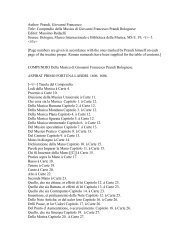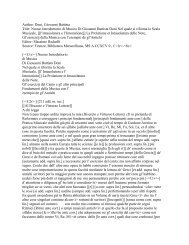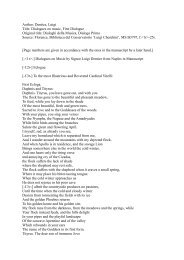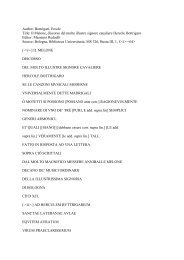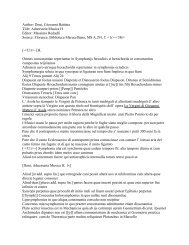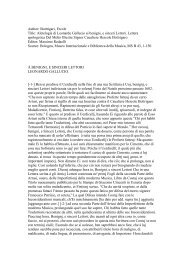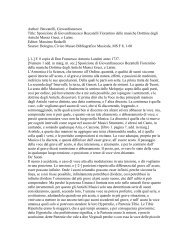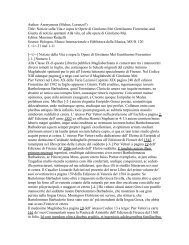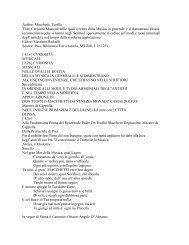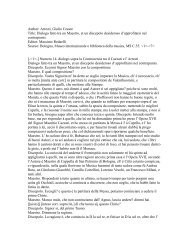Author: Doni, Giovanni Battista - manuscripts of italian music theory ...
Author: Doni, Giovanni Battista - manuscripts of italian music theory ...
Author: Doni, Giovanni Battista - manuscripts of italian music theory ...
Create successful ePaper yourself
Turn your PDF publications into a flip-book with our unique Google optimized e-Paper software.
<strong>of</strong> the tetrachords, so well organised, would be disrupted by the division <strong>of</strong> the<br />
disjunctive tones and the genera and the entire Harmony would be in disarray.<br />
Moreover, if Aristoxenus did not avail himself <strong>of</strong> any other arguments apart from his<br />
requirement what every sound should have its corresponded by fourth and fifth, he did<br />
so because it was sufficient for his scope.<br />
[--] This Statement is demonstrated with the authority <strong>of</strong> other writers and with<br />
other arguments chapter<br />
One will find almost no ancient author who wrote about <strong>music</strong> from whom one may<br />
not derive the truth <strong>of</strong> this statement with certainty, nevertheless, to avoid extending<br />
myself without any need, I will be happy just with these supportive pieces <strong>of</strong><br />
evidence.<br />
Firstly, if one looks at Ptolemy, one sees that he places the Systems <strong>of</strong> any genus with<br />
its Species everywhere and that he places a tone in every octave <strong>of</strong> every mode<br />
besides its two particular tetrachords, as one can see easily from the proportions<br />
contained within the numbers which indicate each note and interval <strong>of</strong> the System.<br />
Moreover, Cleonides, Bacchius and all the writers who wrote compendia says this<br />
expressly. Cleonides, for instance, where he discusses the seven species <strong>of</strong> the octave<br />
which belong each to one <strong>of</strong> the seven modes, says clearly that one has the tone in the<br />
first place, another one in the second and so forth in this way, firstly in the two genera<br />
Chromatic and Enharmonic, and then, separately, in the Chromatic, which, albeit it<br />
has other tones, it also avails itself <strong>of</strong> the same illustration from the fact that it has the<br />
tone <strong>of</strong> the disjunction in one <strong>of</strong> the Seven intervals. Bacchius says the same in his<br />
Isagoge. [-] It is also clear that this is also what reason requires, as, if it were<br />
otherwise, the disposition <strong>of</strong> the tetrachords and <strong>of</strong> the pentachords, or, rather, <strong>of</strong> all<br />
melodies would be disrupted and would change from a body ordered, structured and<br />
divided into all his parts into a disfigured animal as that fish that they call ,<br />
which is really ‘crude and unstructured’. It is obvious that the melody would be<br />
disrupted because all the Modes, would be in disarray, as our good Vicentino does not<br />
believe that they would suit the two most artificial genera, and an octave could not be<br />
found in these two genera constituted only by eight notes, since, for instance, if one<br />
places two conjunct tetrachords in the Chromatic, seven notes will be laid out, which<br />
lack a tone to complete an octave, and, as such tone should be divided necessarily, one<br />
would need another two notes. The same occurs in the Enharmonic, so that in these<br />
two genera there will not be difference <strong>of</strong> [sqb] square and b molle, and many more<br />
drawbacks <strong>of</strong> this type will follow, as, for instance, the loss <strong>of</strong> that beautiful variety<br />
which he modes produce in all the genera with the help <strong>of</strong> this tone <strong>of</strong> the disjunction,<br />
since, (to employ the example above) just as in painting one cannot produce words <strong>of</strong><br />
great perfection by using only two extreme colours, thus in <strong>music</strong> it is not possible to<br />
create perfect melodies just with the large and interval intervals <strong>of</strong> the tetrachords<br />
(which are just as the extremes) [--] but one would need even more the middle<br />
interval, which is the tone, on the basis <strong>of</strong> which some admirable union <strong>of</strong> colours is<br />
produced (which according to Pliny it is the hardest part <strong>of</strong> painting) as one can see in<br />
the rainbow, which, equally, was called harmoge [harmoge] with a word taken from<br />
<strong>music</strong>, which means accord, harmonious combination <strong>of</strong> differing elements or<br />
pleasant union <strong>of</strong> extremes, as the warmth is in between heat and cold. Should anyone<br />
require further arguments as evidence <strong>of</strong> this truth, one should read what Bottrigari<br />
writes in his Discourse addressed to Annibale Melone, Dean <strong>of</strong> the <strong>music</strong>ians <strong>of</strong><br />
Bologna. There, among other matters, one will note Don Nicola’s Inconsistency in



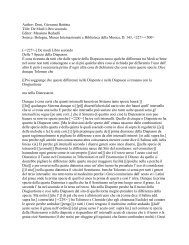
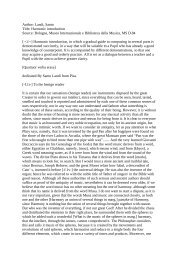
![Doni, Giovanni Battista Title: Trattato Dei Tuoni o [[Harmonie de]]](https://img.yumpu.com/45461005/1/190x245/doni-giovanni-battista-title-trattato-dei-tuoni-o-harmonie-de.jpg?quality=85)
